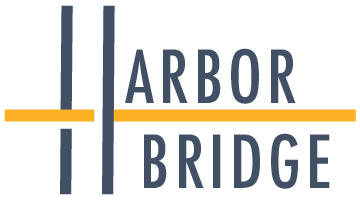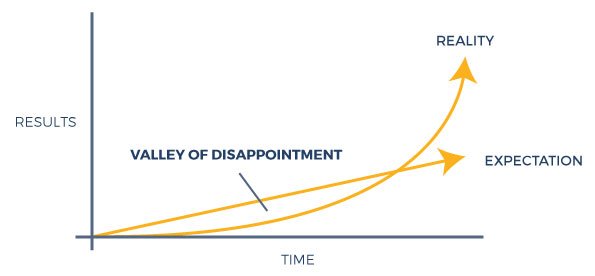Team Resilience and Persistence: Leading Through the “Valley of Disappointment”
On Friday nights, as I shiver in a freezing cold gymnasium watching my 6-year-old struggle to perfect the somersault while his older peers effortlessly execute forward flips, I am reminded of a pivotal stage along the journey towards achieving a goal: the Valley of Disappointment.
This concept, originally attributed to James Clear in his book Atomic Habits, describes the challenging period when progress towards a goal is slow or non-existent. It's a frustrating phase when our expectations don’t match reality and people often throw in the towel and give up. The valley is marked by struggle to maintain motivation and feelings of self-disappointment, yet it is a natural part of progressing towards a goal.
The Valley of Disappointment is the stretch of time when you do not see results as expected. However futile efforts might seem, notice that beyond a certain point, you experience a period of progress which is explosive and exceeds expectations.
In my work supporting people and organizations, I've had the opportunity to observe and engage with the Valley of Disappointment at both the individual and organizational levels.
For individuals, this shows up when they are learning a new skill (like somersaulting!) or when working through a new project. In an organizational context, this phase often coincides with the implementation of new strategies or change management. Employees, initially full of optimism, may find themselves demotivated by the slow pace of progress. The challenge for individuals and leaders is to maintain commitment, stay resilient through setbacks and boost morale.
Leadership Strategies for Navigating the Valley
There are several strategies to navigate employees through this challenging phase:
Set Realistic Expectations: Often, the depth of the valley is amplified by unrealistic expectations. Setting achievable and clearly communicated goals can help maintain momentum, motivation, and morale.
Transparent Communication: Keeping the lines of communication open during this phase is crucial. Offering your team regular updates on progress, even if small, can reinforce a sense of direction and purpose.
Celebrate Small Wins: While in the depths of this valley, it's vital to recognize and celebrate small achievements. This acts as a reminder that progress, however incremental, is being made.
Foster a Culture of Patience and Persistence: Encouraging a workplace culture that values patience and persistence can be a game changer. It’s about building a collective resilience to overcome setbacks and withstand the slow pace of visible results.
Offer Support and Resources: Providing employees with the necessary tools, training and support can make the journey through the valley a smoother ride.
Encourage Peer Support and Collaboration: A supportive community within the workplace reduces the sense of isolation and frustration that might come up during this phase.
The Role of Human Resources
Human Resources professionals and consultants can play an important role in guiding organizations through this valley. When internal HR teams are busy with the day-to-day operations, an HR consultant like Harborbridge can develop people and performance strategies to overcome the unique challenges of this phase, including change management and communication strategies along with approaches to inspire commitment, improve team camaraderie and developing mental resiliency.
Embracing the Valley as a Path to Transformation
While challenging, the Valley of Disappointment is not a bottomless pit. Rather, it is a necessary landscape towards meaningful and lasting change. With the right mindset and approach, leaders and organizations can use this phase as an opportunity to build a more resilient, engaged and productive workforce. Just like my son's determination in mastering the somersault, embracing the struggles in the Valley of Disappointment can lead to remarkable achievements and growth.

